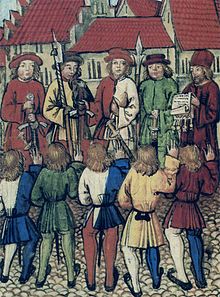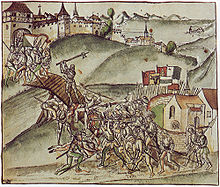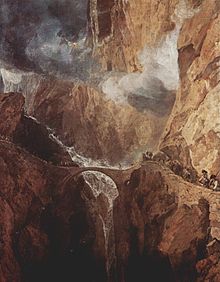Origin and growth of the Old Confederation

Already in the 18th century, the legend was the Rütlischwur widely used as a source of the Confederation even in educated circles.
The origins and growth of the Old Confederation are generally assumed to be between 1291 and 1516. The Old Confederation was established after 1291/1315 around the three original cantons of Uri , Schwyz and Unterwalden, which were designated as Waldstätte . Until 1513, the network of alliances expanded to include more and more partners, most recently to include the state of Appenzell , and it became a power factor in Central Europe. Although further areas were acquired after 1513, the phase of growth of the Old Confederation with the internal split caused by the beginning of the Reformation around 1516 is considered to be over, as the internal disagreement made it impossible to expand the alliance to include additional partners. The conquest of Vaud by Bern and Friborg in 1536, for example, was no longer a collective action by the Old Confederation.
The emergence of the Old Confederation
The disputes between the emperor and the pope in the 13th century favored the independence of the more important cities and valleys of Switzerland. In 1218 Zurich, Bern, Freiburg and Schaffhausen became " imperial cities " after the Zähringers died out ; Uri (1231) and Schwyz (1240) received the privilege of imperial immediacy . This means that these cities and regions were directly under the emperor or the king and were excluded from the rulership of the local counts. In this way, Emperor Friedrich II secured the route over the Gotthard while he was at war with the Lombard cities, and secured the loyalty of the cities in the battle with Pope Innocent IV. After Friedrich II was banned by the Pope and declared deposed in 1245 , then Bern, Basel and Zurich also believed in the emperor. The end of the Hohenstaufen dynasty and the beginning of the interregnum in the empire mark the transition to the late Middle Ages for what is now Switzerland . At the same time, around 1230, the Gotthard Pass became a trade route with the construction of the Devil's Bridge . The Bündner passes were still more important, however.
The "Waldstätte" Uri (1231) and Schwyz (1240) obtained freedom letters from Friedrich II in the 13th century , which guaranteed them imperial immediacy with extensive self-administration by a Landammann . In 1273 Rudolf I of Habsburg became king of Germany. He reorganized the imperial property in the former Duchy of Swabia and appointed bailiffs as representatives of the royal judiciary. This also happened in the Reichsvogtei der Waldstätte. The bailiffs were hostile to the local nobles, who had usurped the imperial property during the interregnum , and viewed them more as representatives of the interests of the Habsburgs than of the empire.

Rudolf I died on July 15, 1291. The first federal letter between Uri , Schwyz and Unterwalden from 1291, which explicitly “does not want to overturn the existing conditions”, was probably a direct result of his death in order to oppose any legal changes by the successor of the To secure the king. This covenant is certainly preceded by an older one, probably from 1240. In later times, this federal letter was dated August 1, 1291 (without historical evidence for it) and combined with the Rütli oath; the founding myth of Switzerland emerged. With the confusion surrounding Rudolf I's successor, the Swiss Habsburg Wars began , which lasted until 1511 with numerous interruptions. The enmity between the Confederates and the Habsburgs, the dominant feudal dynasty in central Switzerland and the former duchy of Swabia , was during the expansion phase, a characteristic element and the heterogeneous members agreed the covenant, but led at times also to internal conflicts, as in the Old Zurich War .
In 1309 King Heinrich VII confirmed the imperial immediacy of Uri and Schwyz and now also included Unterwalden; the three forest sites were placed under a royal governor. In recent research, the privilege of 1309 is seen as an important step towards the formation of an alliance later. In 1315 the Habsburg Leopold I of Austria saw himself induced by border disputes between the Abbey of Einsiedeln , which was under the Habsburg bailiwick, and the state of Schwyz to use armed force against the Waldstätte. The Schwyz had plundered and desecrated the monastery in the so-called Marchenstreit and had even been excommunicated . However, the knight army of Habsburg vassals was ambushed by the Confederates as they approached and was almost completely destroyed in the battle of Morgarten .
The eight ancient places

After the Waldstätte victory over Habsburg near Morgarten, a number of towns in the Swiss plateau joined the Confederation. 1332 the Habsburg city of Lucerne , 1351 Zurich , 1352 Zug and 1353 Bern . These cities were also under external pressure. The imperial city of Zurich had internal difficulties since the guild revolution in 1336, which led to a feud with Habsburg in 1350 - the politically isolated mayor Rudolf Brun was left with the alliance with the Waldstätten in this situation. The imperial city of Bern was also in a threatening confrontation with the nobility of western Switzerland and the controversial Emperor Ludwig the Bavarian (" Laupenkrieg ") when it, together with its allies ( Burgundian Confederation and others), entered into an eternal alliance with the Waldstätten.
The state of Glarus , which belongs to the Säckingen monastery , was occupied as a Habsburg bailiwick as part of the feud between the Confederates and Duke Albrecht II of Austria. In 1352 Zurich, Uri, Schwyz and Unterwalden signed the so-called "evil covenant" with the people of Glarus. Glarus was not recognized as an equal partner, but was rather a protectorate of the four places.
The resulting structure is referred to as the " Eight Old Places ". However, it is not about a confederation of states, but rather a conglomerate of alliances between the individual partners. Bern in particular maintained an extensive alliance system with the so-called Burgundian Confederation, through which Solothurn and Biel, among others, also joined the Eight Old Locations as allies (so-called `` allies '' ) in 1353 .
With the city of Lucerne reaching out to the Habsburg country towns and lordships in their vicinity, Duke Leopold III saw himself . forced by Austria to intervene further in central Switzerland in 1385. In the so-called Sempach the Waldstätte and Lucerne were also without the help of Bern and Zurich by the victory in the Battle of Sempach finally solved in 1386 by Habsburg. The area around Lucerne, the Entlebuch and Einsiedeln were lost to Habsburg. The state of Glarus, which also successfully broke away from Habsburg in the Battle of Näfels in 1388, rose to the rank of an equal place.
To the distribution of the inheritance of the Counts of Toggenburg it came from 1436–1450 to the Old Zurich War between the Confederates and Zurich, which dealt with Emperor Friedrich III. von Habsburg had allied. In this conflict, Zurich was defeated by St. Jakob an der Sihl and had to dissolve its alliance with the emperor. In this conflict, too, the particular cruelty and fearlessness of the Central Swiss warriors played an important role. At Greifensee , for example, the entire Zurich crew of the castle was executed because they refused to surrender without a fight. One of Friedrich III. Requested huge French army of around 30,000 men, the so-called Armagnaks , turned back despite their victory at St. Jakob an der Birs in 1444, because the federal vanguard (only around 1,600 men) with around 6,000 opposing fighters in their downfall had taken death.

Duke Sigismund of Austria concluded the so-called "Eternal Direction" with the Confederation in Constance in 1474/75, with which the longstanding hostilities between Habsburg and the Confederation came to an end. At the same time, the confederates allied themselves with the imperial cities of Strasbourg , Basel , Colmar and Schlettstadt as well as the prince-bishops of Basel and Strasbourg .

Between 1474 and 1478, in the Burgundian Wars , the Confederates grappled with Duke Charles the Bold of Burgundy , who had risen to become the most powerful ruler between France and the Habsburg Empire. The war broke out against the dukes of Savoy , who were allied with Burgundy , because of the military expansion of Bern and the Upper Valais , which was allied with it. In 1476, Duke Charles the Bold undertook a campaign against Bern, which the Confederate and Alsatian allies came to the rescue. Karl was defeated first at Grandson and then at Murten . The following year, the Confederates, as allies of the Duke of Lorraine, again marched against Charles and beat him again at Nancy .

The spectacular success of the Swiss warriors against the highly armed Burgundian knight armies cemented the myth of the invincibility of the Swiss. As a result, all the important princes in Europe began to recruit federal mercenaries. The emigration to pay service abroad, the so-called " rice running ", remained widespread up to the 19th century, especially in the poorer mountain regions of Switzerland.
Within the confederation structure, during the Burgundian Wars the weight clearly shifted to the cities. The inclusion of the facing cities Freiburg im Üechtland and Solothurn in the alliance therefore aroused resistance from the rural areas. The breakup of the federation into a city and a state federation could be prevented by the " Stanser Verkommnis " 1481 with the mediation of the hermit Niklaus von Flüe .
The Thirteen Ancient Places

After the victory over Burgundy, the Swiss Confederation had become the dominant power in southern Germany. The Swabian nobility, above all Habsburg, opposed the growing influence of the Confederates in Sundgau , Breisgau , Klettgau and Hegau in the Waldshut War of 1468 and in the Swabian War of 1499 in vain. The Swabian War was primarily about the implementation of the imperial reform of 1495, but actually this was the last attempt by the House of Habsburg to enforce its rights in the lost areas to the left of the Rhine. In the peace treaty at Basel , the German King Maximilian I then had to recognize the factual independence of the Confederation within the empire. The affiliation of the Confederates to the Holy Roman Empire was actually undisputed until 1648, since the statehood of all federal places was based on imperial immediacy , traditional privileges and rights, which ultimately found their source in the instance of the Roman-German Empire.

The Swabian War marked the end of the expansion of the Confederation towards the north. With the exception of smaller areas, the Swiss northern border remained practically unchanged after the accession of the cities of Basel and Schaffhausen in 1501 and the state of Appenzell in 1513. Constance remained outside the Confederation, although it was still allied with Bern and Zurich. The cities of Mulhouse and Rottweil , on the other hand, continued to be regarded as associated places until 1632 and 1798, respectively . The most important locations remained the prince abbey and city of St. Gallen , the Free State of the Three Leagues , the Valais , the city of Biel and the county of Neuchâtel .
The Habsburg-French opposed extending around Burgundy and after 1477 Duchy of Milan revealed pulled the Confederation as the main supplier of mercenaries to both warring parties as well as independent power in a conflict at the European level. The biggest problem for the internal cohesion of the Federation gave a presentation on competition of the French and the German party lucrative to conclude pay agreements. In the Ennetbirgischen campaigns within the Mailänderkriege 1499 to 1525 found the military significance of the Confederation both its peak and their end point.
Under the influence of the Valais bishop and cardinal Matthäus Schiner , the Confederation renounced the renewal of the pay alliance with France in 1509. To this end, the following year an alliance was concluded with Pope Julius II, who had also employed Swiss mercenaries in the Cohors Helvetica , the papal Swiss Guard , since 1506 . Julius II wanted to break French rule in Lombardy , which is why the Confederates repeatedly moved to Italy. The exits to Pavia in 1512 and to Novara in 1513 were victorious and brought the Swiss Confederation and the allied three leagues rule over Ticino and Valtellina and the protectorate of the Duchy of Milan .
The beginning of the Reformation divided the various parts of the Confederation even more than before and weakened their position in the Italian disputes between Habsburg, the Pope and France. In 1515 the French King Francis I defeated a federal army near Marignano that had been decimated by the withdrawal of numerous estates . In the Eternal Peace of 1516, Franz I nevertheless granted the Confederates and Graubünden their conquests south of the Alps. With this, the southern border of the Swiss Confederation was essentially consolidated by 1798. The acquisitions of the Confederation in Ticino were administered as the ennetbirgische bailiwicks by the bailiffs as common lords . In 1521, the Swiss Confederation concluded a new pay alliance with France, which obliged them to employ up to 16,000 men. (After 1600 and 1650, these pay alliances between the individual towns and France were extended and, in 1663, confirmed together with a federal oath in Paris before Louis XIV .) In the further struggle for Milan between France and Habsburg, the confederates therefore still played an important role. Both battles with substantial Swiss participation at Bicocca 1522 and Pavia but 1525 ended with a defeat of France and the Swiss. With this, the federal great power politics in Europe definitely came to an end. The export of mercenaries through various federal locations continued until the final ban in 1859. The only exception since then has been the papal Swiss Guard .
Timeline

See also
- History of Switzerland
- List of wars and battles in Switzerland
- Swiss history 1520–1712: Reformation and Counter-Reformation in Switzerland
- Switzerland in the Middle Ages
- Swiss Habsburg Wars
literature
- Andreas Würgler: Confederation. In: Historical Lexicon of Switzerland .
- Hans Conrad Peyer : Constitutional history of old Switzerland. Schulthess, Zurich 1978.
- Historical Association of the Five Places (ed.): Central Switzerland and the early Confederation. Anniversary publication 700 years of the Swiss Confederation. 2 volumes. Olten 1990.
- Guy P. Marchal : Swiss history of use: historical images, myth formation and national identity. Schwabe, Basel 2006, ISBN 3-7965-2242-4 .
- Claudius Sieber-Lehmann : Late medieval nationalism: the Burgundian Wars on the Upper Rhine and in the Confederation. Vandenhoeck & Ruprecht, Göttingen 1995, ISBN 3-525-35430-4 ( publications of the Max Planck Institute for History. Vol. 116).
- Roger Sablonier : Founding time without confederates. Politics and society in Central Switzerland around 1300. here + now, Baden 2008, ISBN 978-3-03-919085-0 .
- Peter Stadler : epochs of Swiss history. Orell Füssli, Zurich 2003, ISBN 3-280-06014-1 .
- Bernhard Stettler: The Confederation in the 15th Century. The search for a common denominator. M. Widmer-Dean, Zurich 2004, ISBN 3-9522927-0-2 .
- Paul Meyer (Ed.): The Swiss chronicler Aegidius Tschudi report on the liberation of the forest site. Beck, Munich 1910.
Remarks
- ↑ See Thomas Maissen : Schweizer Heldengeschichten - and what's behind them. 2nd edition Baden 2015, p. 52 ff.
- ↑ Roger Sablonier: Founding time without confederates. Politics and society in Central Switzerland around 1300. Baden 2008, p. 116 ff.




